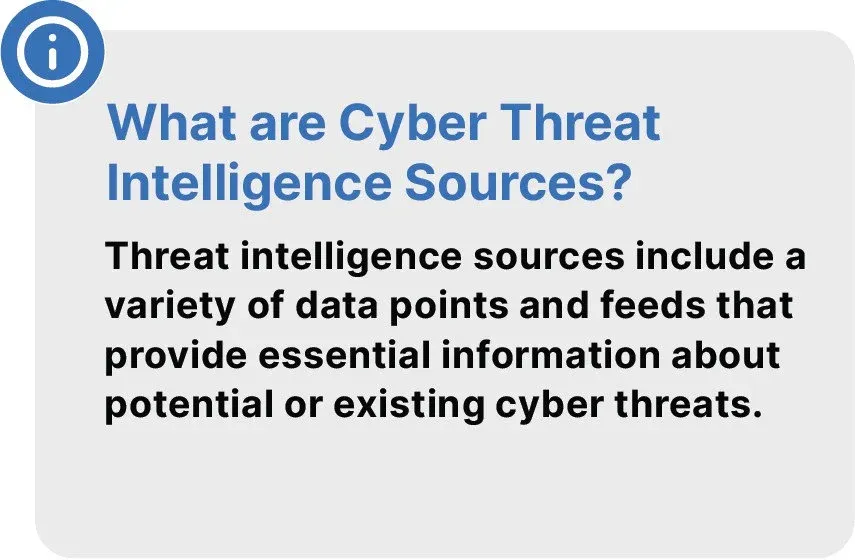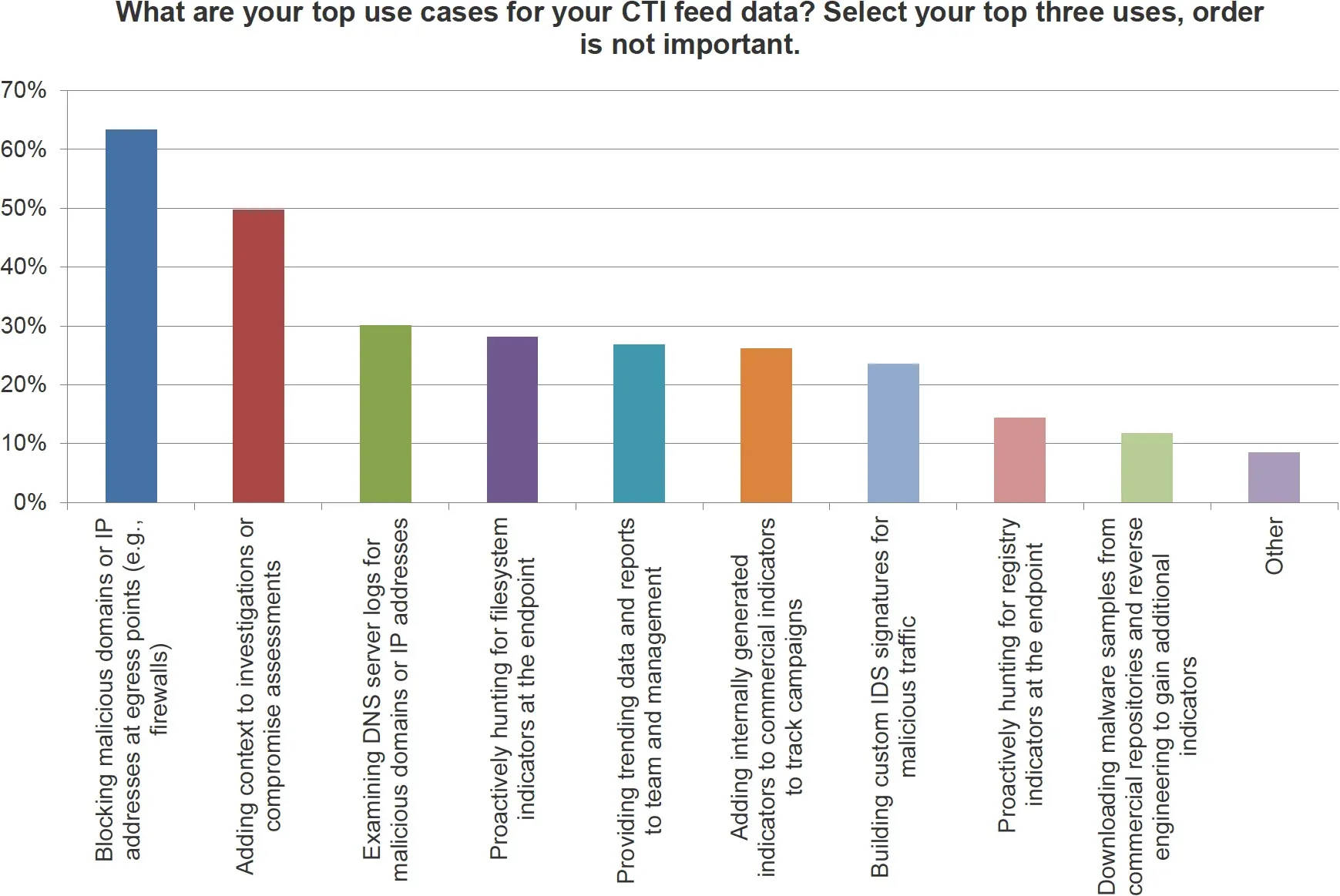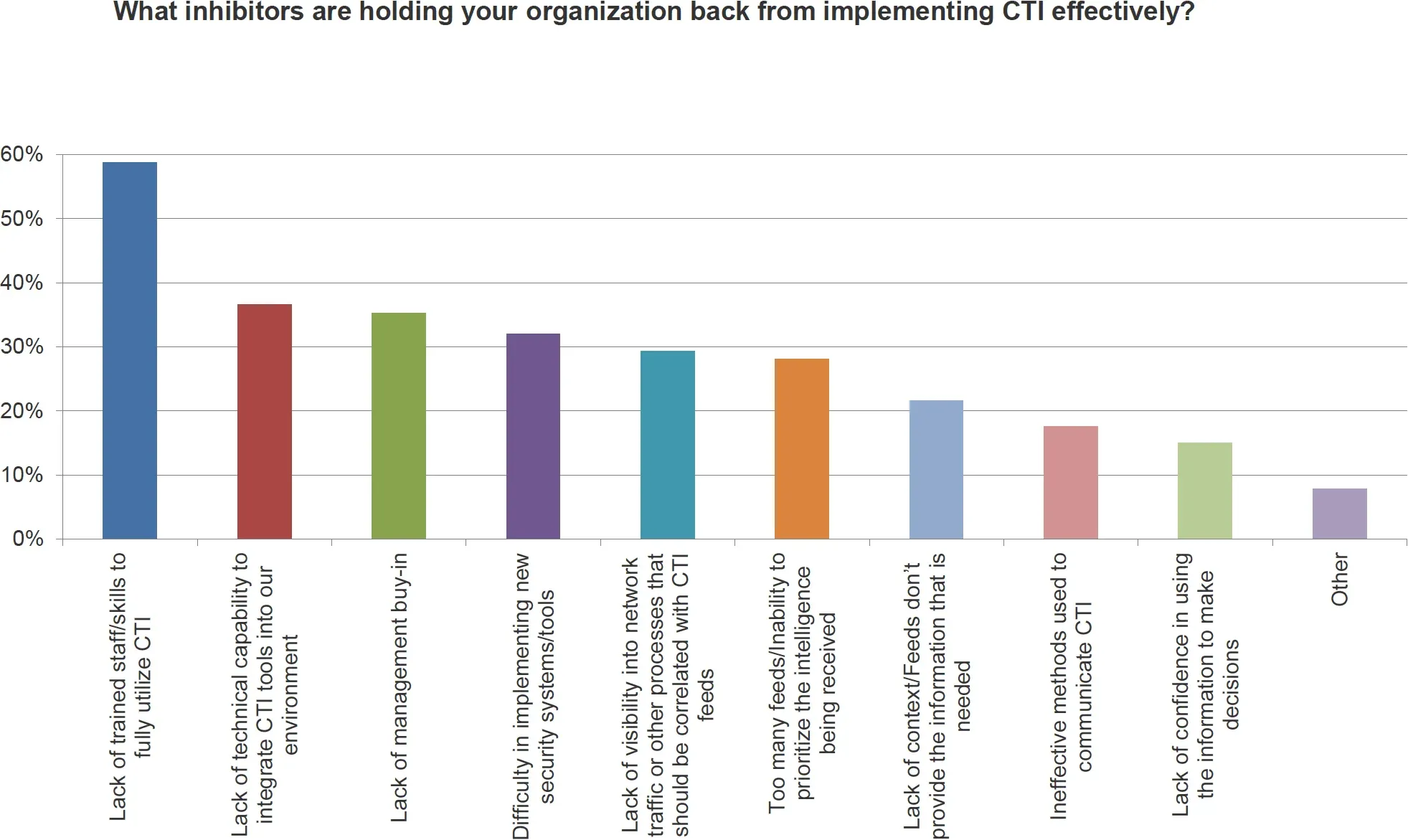What are Threat Intelligence Sources?
Editor’s Note: The following blog post is a partial summary of a SANS webinar we co-hosted with Dave Shackleford.
Many organizations perceive threat intelligence to be “hard” and out of their reach. In reality, if you have a clear vision from the outset, you can tailor your program to solve specific problems instead of simply highlighting skills deficiencies.
Time ago, Recorded Future co-hosted a webinar with SANS Institute, intending to help security-conscious organizations identify and avoid some of the biggest pitfalls in threat intelligence. The webinar covered how organizations should think about collecting, analyzing, and disseminating threat intelligence data from various sources to develop actionable intelligence for security teams and stakeholders. This enables them to protect their digital assets and respond effectively to cybersecurity incidents, and the dangers of relying too heavily on a single source.
The speakers were Chris Pace, technology advocate at Recorded Future, and Dave Shackleford, SANS analyst, instructor, and course author.
Key Takeaways
- If you don’t approach cyber threat intelligence with a clear goal, your choice of sources will influence your understanding of how and where intelligence can provide value to your organization.
- Many organizations perceive threat intelligence to be “hard” and out of their reach. In reality, if you have a clear vision from the outset, you can tailor your program to solve specific problems instead of simply highlighting skills deficiencies.
- Relying purely on threat feeds is a recipe for information overload and alert fatigue.
- There are many different sources of cyber threat intelligence, each with their own advantages and drawbacks. Maximum results come from automatically combining multiple sources to corroborate and contextualize intelligence before passing it over to human analysts.
- Establishing a continuous feedback loop to adapt to the evolving threat landscape is crucial. By collecting, analyzing, and disseminating threat intelligence data, security teams can develop actionable intelligence for stakeholders.
What are Cyber Threat Intelligence Sources?
Threat intelligence sources include a variety of data points and feeds that provide essential information about potential or existing cyber threats. They enable organizations to protect their digital assets (a key part of the attack surface) and respond effectively to cybersecurity incidents.

These sources gather threat intelligence data from various channels, such as real-time threat intelligence feeds that monitor malicious activities and patterns across the internet, and internal security logs from an organization’s systems, which help identify unusual behaviors and past attack signatures.
Types of Threat Intelligence Sources
Threat intelligence is a continuous process involving the collection, analysis, and application of threat intelligence data regarding potential or existing threats. There are many different sources of threat intelligence data, each with its advantages and drawbacks. Maximum results come from automatically combining multiple sources to corroborate and contextualize intelligence before passing it over to human analysts, often within a security operations center. This approach is crucial for maintaining and enhancing the overall security posture of an organization.
If you don’t approach threat intelligence with a clear goal, your choice of sources will influence your understanding of how and where intelligence can provide value to your organization. Relying purely on threat feeds is a recipe for information overload and “alert fatigue.”

Of course, to have an understanding of which problems can be solved using threat intelligence, you first need to understand what intelligence is potentially available. During the webinar, both Dave and Chris spent some time covering the most common sources.
1. Open Source Threat Intelligence Feeds
Open Source Intelligence (OSINT) involves gathering information from publicly available sources. These include news articles, blogs, social media, forums, and public databases. In 2023, most of the data gathered for threat intelligence was from external sources such as news and media reports, along with community or industry groups.
There are hundreds of these available, covering every aspect of security you can imagine. Implement a basic threat intelligence platform (TIP), and you have everything you need to start digesting truly unmanageable numbers of alerts. Additionally, platforms that provide open access to community generated threat data from a global community of threat researchers and security experts. This fosters collaborative research and automates the process of updating security infrastructure with threat data from any source, available in various formats including STIX, OpenIoC, MAEC, JSON, and CSV.
2. In-House Threat Intelligence
Often referred to as “security analytics,” in-house intelligence is produced by incident response teams, security operations center (SOC) personnel, security analysts, and security professionals. Internal network monitoring involves analyzing data from within an organization’s systems. This includes logs from firewalls, intrusion detection systems (IDS), and other network devices.
3. Vertical Communities
Certain industries and verticals have access to intelligence-sharing communities, such as the Financial Services Information Sharing and Analysis Center (FS-ISAC). Additionally, the Cybersecurity and Infrastructure Security Agency (CISA) plays a crucial role as an infrastructure security agency, providing threat intelligence information and automated indicator sharing (AIS) threat intelligence feed. These communities can be extremely valuable, but are often gated, meaning even organizations processing a high volume of transactions may be disallowed access if they don’t possess the “right” brand name.
4. Commercial Services
In 2022, around 78% were using commercial threat intelligence feeds as their main threat intelligence source. Commercial threat intelligence services offer curated and real-time data about the latest threats and vulnerabilities.
Offered by dozens of security vendors, often referred to as providers, commercial threat intelligence services vary wildly in quality and scope. These services, provided by cybersecurity firms, aggregate and analyze information from various sources, delivering detailed and actionable intelligence.
At their best, they offer vital insights into one or more areas of intelligence with far fewer false positives than their open-source alternatives. However, it’s important to note the availability of a free threat intelligence platform like MISP, which allows users to search, scan, enrich, and share threat information without any cost. At their worst, commercial services are expensive and fail to deliver truly actionable intelligence.
5. Dark Web Intelligence
The dark web is a part of the internet that is not indexed by traditional search engines and is often used for illicit activities. Try to forget about your preconceptions. Functionally, the dark web isn’t “everything not indexed by Google.” From the cybersecurity perspective, the dark web is around 500–600 underground forums, which can only be accessed using specialized browsers.
Monitoring the dark web can provide early warnings about new threats, including data breaches and emerging malware. The most recent darling of the threat intelligence world, the dark web offers organizations the chance to identify stolen assets, explore threat actor targeting, analyze exploit kits, and much more. By focusing on specific types of threat activity, such as malware URLs or spam IP addresses, organizations can gain valuable insights and context from dark source threat feeds.
Unfortunately, given the need to understand multiple languages (including relevant slang) and the potential for drawing the attention of dangerous parties, gathering these gems in-house can be more trouble than it’s worth. Many of the more secretive (and thus valuable) communities are extremely difficult to join, requiring existing members to vouch for new applicants and demanding joining fees running to thousands of dollars.
Your Sources Determine How You 'See' Threat Intelligence
To kick things off, Dave put up a graph depicting some of the results from a SANS survey conducted last year on cyber threat intelligence. In this case, respondents were asked for their top three use cases for threat intelligence within their organization.
Straight away, we saw something interesting. A very high proportion of organizations were already using threat intelligence data to block malicious domains and IP addresses, with many also using it to add context to investigations or compromise assessments.

Very few organizations, though, went further than this. The third most common usage of threat intelligence was employed by less than a third of all respondents, and things only descended from there.
Recorded Future’s own Chris Pace explained why:
“If you have a stack of feeds that give you malicious domains and risky IP addresses in a very binary way, that’s how you’re going to perceive the usefulness of threat intelligence because that’s what’s accessible to you.”
“I think the reason that number on the left of the graph is so high, and the other more interesting and potentially more useful things are lower down, is the perceived barrier to entry for accessing that intelligence, ingesting it, and converting it into a usable format.”
Common practice dictates that a threat intelligence initiative should start with a basic platform and a few open-source feeds. And in a sense that’s understandable, as it’s certainly the cheapest way to get started.
But in reality, single-source threat intelligence just doesn’t work. Instead of solving an existing operational problem or addressing a known risk, using a single source can force you into a very reactive position, whereby analysts are forced to constantly triage new alerts that contain little (if anything) in the way of context.
And that’s just it. If all you currently have access to are stream-of-consciousness threat feeds, a lot of the worthwhile aspects of threat intelligence are going to seem unattainable. Sadly, many organizations assume this is a failing on their part, but in reality, it’s nothing more than a basic misunderstanding of how powerful threat intelligence facilities are built.
To truly leverage threat intelligence information, organizations need access to platforms and tools that gather, analyze, and visualize cyber threat intelligence. This includes platforms designed for information sharing, data analysis to reduce false positives, and tools for identifying anomalous patterns in threat data.
Challenges in Threat Intelligence
As you can see, open-source intelligence is just the tip of the iceberg. Unfortunately, though, since many organizations quickly become overwhelmed by the sheer quantity of low-yield alerts these sources provide, they never can take on additional sources.
The simple truth of threat intelligence is that more isn’t always better. When it comes to alerts, more is nearly always worse.
“It’s not surprising that somebody would be overwhelmed by the magnitude of feeds and data that are available,”
Chris noted during the webinar.
“As vendors, as providers of threat intelligence, it’s down to us to deal with that problem. It shouldn’t be down to an organization to try to drink from the fire hydrant of data.”
Note the use of the term “fire hydrant.” In reality, the reason why many organizations feel overwhelmed by threat feed alerts is that what they’re receiving isn’t intelligence at all, it’s raw data. To be considered intelligence, that data would need to be filtered, processed, and formatted to ensure only relevant and valuable alerts are fed through the human analysts. Integrating threat intelligence feeds with other security tools and platforms can help automate this process, making the data actionable and reducing noise and false positives.
Most of the time, this just doesn’t happen.
So if more alerts isn’t the answer, and most feeds provide little more than raw data, how can organizations possibly be expected to develop a powerful threat intelligence facility? This is where Dave and Chris introduced us to the “two Cs” of threat intelligence: context and corroboration.
To address the overwhelming quantity of low-yield alerts, organizations need to focus on collecting, analyzing, and disseminating threat intelligence data. This involves establishing a continuous feedback loop to adapt to the evolving threat landscape, ensuring that the data is actionable and relevant for security teams and stakeholders.
'Threat Intelligence Is Hard'
Of course, sources aren’t the only barrier to effective threat intelligence gathering. To further explain why many organizations are finding threat intelligence such a struggle, Dave put up a second SANS survey graph.

Take a look at the top two barriers to effective threat intelligence: Lack of trained staff, and lack of technical capability.
Now, the skills gap isn’t exactly a new story, but consider the third most common barrier: Lack of management buy-in. If you had to guess, it seems highly likely that this absence of buy-in from executives and budget holders is at least partly responsible for the lack of skilled security professionals needed to implement and maintain a powerful threat intelligence facility.
Now, look at the rest of the barriers cited by survey respondents. For the most part, they relate to the high volume, lack of perceived relevance, and lack of prioritization. Put simply, many organizations are overwhelmed with alerts, too many of which are false positives.
Once again, this is an issue of starting from the wrong position. Since management buy-in can be difficult to come by, organizations seek to launch their threat intelligence initiative in what appears to be the easiest and cheapest way: threat intelligence feeds.
But in practice, these feeds are anything but easy to use. They absorb a huge amount of analyst time, deliver very little, and worst of all, they give organizations the toxic view that threat intelligence is simply about playing “whack-a-mole” with the latest vulnerabilities and malicious domains.
“**It’s a self-fulfilling prophecy,” explained Dave. “You get this easily understandable data that’s readily accessible, and you feel like you can immediately put it to use … but it stops there**.”
So if not with threat intelligence feeds, where should you start? Simple: Start by solving an existing problem.
“It doesn’t matter whether it’s brand monitoring, leaked credential monitoring, uncovering emerging threats, or vulnerability identification and prioritization,”
explained Chris.
“You need to have a goal first before you can get into the weeds of how you are going to use threat intelligence.”
The Importance of 'All-Source' Corroboration
There’s no getting around the fact that having more data available to you will necessarily improve the likelihood of receiving the alerts your organization needs to remain secure.
At the same time, as we’ve already seen, having access to massive quantities of threat data is unmanageable for even the largest and most highly skilled teams of analysts.
So in a world where skilled analysts are at a premium, balancing the need for more threat intelligence data with the imperative to minimize alerts is the name of the game. The answer is simple:
Leveraging Threat Intelligence Sources for Security Professionals
As threat intelligence begins to mature, and organizations become more familiar with it, striking a balance between these two things will become the ultimate goal for anyone looking to incrementally improve their threat intelligence capability. Emphasizing actionable threat intelligence is crucial, as it provides high-quality, prioritized information extracted from real-time security operations, investigations, and research. Collecting, analyzing, and disseminating threat intelligence data from various sources is essential to develop actionable intelligence for security teams and stakeholders.
To see all-source threat intelligence in action, sign up for our free Cyber Daily email to see the top daily results for technical indicators such as top targeted industries, threat actors, and exploited vulnerabilities. And book a demo today to explore how Recorded Future can integrate diverse threat intelligence sources into your security strategy.

Esteban is a seasoned security researcher and IT professional with over 20 years of experience, specializing in hardening systems and networks, leading blue team operations, and conducting thorough attack surface analysis to bolster cybersecurity defenses. He's also a skilled marketing expert, specializing in content strategy, technical SEO, and conversion rate optimization. His career includes roles as Security Researcher and Head of Marketing at SecurityTrails, before joining the team at Recorded Future.
Related
